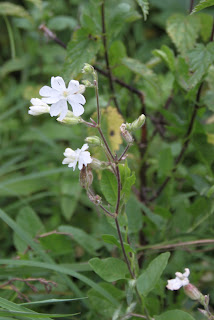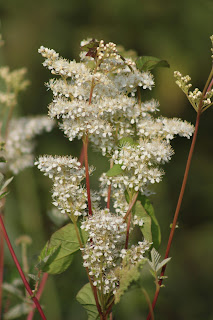All the pictures here were taken on 1st September. The fruits were heavy on the trees at that time.

There was a good crop of elderberries this year. I picked a few pounds in August and my gallon of elderberry wine has now finished its strong initial fermentation and is quietly maturing.
But, in contrast to the elderberries above, the pretty berries shown here are not for consumption. Starting green, turning through red to black, the fruits of the wayfaring tree are described in an interesting way as "mildly toxic".
As is often the case with berries, they seem to be harmless to birds and provide them with a useful autumn meal.

There were still wild plums on the trees on that day (left), but the trees are quite tall and there were easier pickings on the pathway through the wood walk. (right)

Further along the wood walk I noticed the berries (left) of black bryony hanging in a tree from the dry stems of the vine. The bryony leaves are all dry and shrivelled before the berries have ripened.
In contrast the bright red fruits (right) of the nearby hawthorn have been shining out for some time while the leaves of the tree are still fresh and green.
The bryony berries are poisonous whereas the hawthorn are just unpalatable. The young hawthorn leaves in spring though are quite pleasant to eat.
Near the bypass there were still some interesting flowers to note.

On the left are flowers of wild basil, not closely related to the culinary herb, it seems. I couldn't detect any aromatic qualities in the leaves.
On the right is a stem of slender St John's wort. There are some good clumps of it amongst the long grasses.
Surprisingly spectacular are its red seedheads shown below left.

My final plant for September(right) is a particularly interesting one. It does not stand out strongly amongst the grasses but is quite common in the area. It is red bartsia, known as a "semi-parasitic" plant. Its roots invade the tissues of the roots of the surrounding grasses and steal nutrients from them.
Although it does not show well in the picture, the leaves have a reddish tinge (hence the name?). This is because they have less need for green chlorophyll to synthesize their own nutrients.


















































